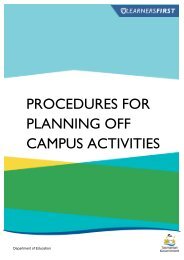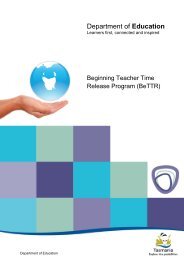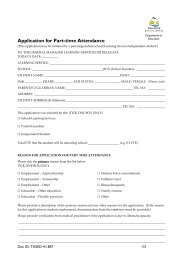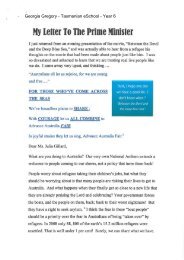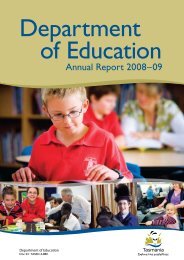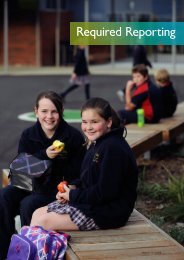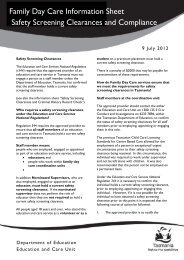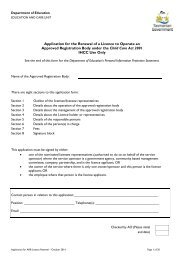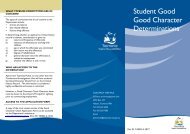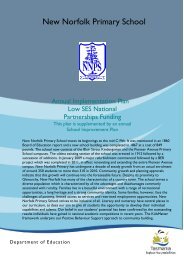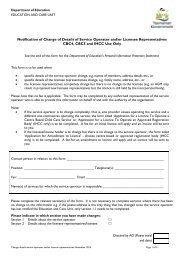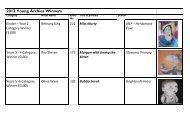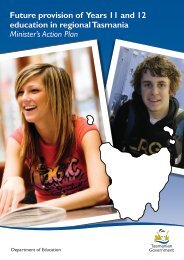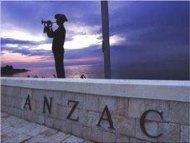Education
DoE Annual Report 2012-2013 - Department of Education
DoE Annual Report 2012-2013 - Department of Education
- No tags were found...
You also want an ePaper? Increase the reach of your titles
YUMPU automatically turns print PDFs into web optimized ePapers that Google loves.
Lead School/<br />
Lead Teacher<br />
strategy<br />
The Tasmanian Literacy and Numeracy Framework 2012–<br />
2015 was introduced to support schools within a broad<br />
framework to enable the development of their whole<br />
school approach, and, to provide systemic direction for<br />
the future.<br />
• The Literacy and Numeracy Framework outlines the<br />
priorities and approaches for government schools to<br />
ensure that students develop the skills required for<br />
participation and growth throughout their education.<br />
The emphasis on effective leadership and teaching is<br />
underpinned by the importance of utilising evidence<br />
based approaches. The Lead School/Lead Teacher<br />
strategy also supports reflective practice and sharing<br />
of best practice.<br />
• Network lead schools (one per network) provide<br />
leadership in learning and share good practice across<br />
all schools in their networks. Network lead teachers<br />
based in each lead school provide leadership, direction<br />
and high level support to all principals and schools<br />
across the network in the implementation of the<br />
Literacy and Numeracy Framework.<br />
• A Principal <strong>Education</strong>al Officer – Literacy and<br />
Numeracy has been funded to coordinate the<br />
implementation of the Literacy and Numeracy<br />
Framework with support from <strong>Education</strong>al<br />
Performance Services. Officers work in close<br />
cooperation to provide a coordinated approach to<br />
literacy and numeracy data collection and analysis at<br />
school and state levels.<br />
• Principal network leaders work with network lead<br />
teachers and network lead school principals to provide<br />
support in:<br />
º º prioritising areas of need and recipients of support<br />
º º following-up on desired outcomes from<br />
professional learning delivery<br />
º º developing the culture of shared responsibility<br />
between schools<br />
º º making recommendations regarding professional<br />
learning needs at local and state level.<br />
Supporting<br />
Literacy and<br />
Numeracy<br />
Success: A<br />
teacher’s<br />
resource for<br />
Early Years to<br />
Year 12<br />
The Supporting Literacy and Numeracy Success booklet was<br />
produced to support the significant work of all teachers,<br />
leaders and principals from Early Years to Year 12 in<br />
improving literacy and numeracy outcomes for students.<br />
It is designed to be a practical resource to support the<br />
implementation of the Tasmanian Literacy and Numeracy<br />
Framework 2012–2015 and the Australian Curriculum.<br />
This document was developed in consultation, and with<br />
contributions from, teachers, principals and leaders.<br />
It was distributed to teachers and early years educators<br />
at the start of the 2013 school year. Further support for<br />
implementing the key actions outlined in the resource<br />
has been provided through the work of network<br />
lead teachers.<br />
Raising the<br />
Bar (RTB)<br />
The goal of the Raising the Bar (RTB) initiative is to<br />
have more children finish primary school and start<br />
their secondary education with functional literacy and<br />
numeracy skills.<br />
The department committed $8 million to this initiative in<br />
2012–13 and a further $8 million in 2013–14 to continue<br />
the program. An additional $3 million was committed<br />
in 2013–14 to provide support to a wider group of<br />
secondary schools.<br />
Additional RTB funding of $3 million in 2011–12 was<br />
provided to extend the RTB initiative into government<br />
secondary schools (RTB 7+). This funding initially targeted<br />
students in Years 7 and 8, but has since broadened to<br />
encompass students from Years 7–10. This strategy will<br />
result in an increased number of students finishing secondary<br />
school with functional literacy and numeracy skills. The<br />
implementation of this initiative has provided additional<br />
staffing to selected secondary schools whilst building teacher<br />
capability and a whole-of-school improvement approach.<br />
The 5–8<br />
Project:<br />
Supporting<br />
Literacy and<br />
Numeracy<br />
across Years<br />
5 to 8<br />
The department is working with the UTAS Faculty of<br />
<strong>Education</strong> on a project to improve literacy and numeracy<br />
across Years 5 to 8. The project targets the transition<br />
from primary to secondary school – in response to the<br />
outcomes of NAPLAN results in Years 7 and 8.<br />
The purpose of the action research is to explore issues,<br />
share best pedagogy, beliefs and practices to investigate<br />
how the performance of students in Year 7 and 9 can<br />
be improved. The focus of the research will be on<br />
engagement, transition and retention through common<br />
approaches to literacy, numeracy and attendance. The aim<br />
is to develop and trial a number of ideas and initiatives that<br />
may be transferable to all Tasmanian Government schools.<br />
Five secondary schools and one combined school are<br />
working with their associated primary schools as clusters<br />
in action-based research – with a strong focus on teacher<br />
professional learning. The schools and their clusters are<br />
located in various regions with each location representing an<br />
opportunity to explore a related but varied challenge.<br />
Participating schools are:<br />
• Scottsdale Cluster – Scottsdale High School,<br />
Scottsdale Primary School, Ringarooma Primary School,<br />
Bridport Primary School<br />
• Penguin Cluster – Penguin High School,<br />
Penguin Primary School, Riana Primary School<br />
• Ogilvie/New Town Cluster – Ogilvie High School,<br />
New Town High School, New Town Primary School,<br />
Lenah Valley Primary School, Bowen Road Primary School<br />
• Tasman Cluster – Tasman District School.<br />
The project commenced in January 2013 and will operate for<br />
12 months initially, with the view to extend beyond this time.<br />
Pre-Compulsory and Compulsory <strong>Education</strong> » Literacy and Numeracy<br />
31



